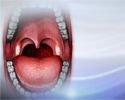Sydenham chorea
St. Vitus dance; Chorea minor; Rheumatic chorea; Rheumatic fever - Sydenham chorea; Strep throat - Sydenham chorea; Streptococcal - Sydenham chorea; Streptococcus - Sydenham choreaSydenham chorea is a movement disorder that occurs after infection with specific bacteria called group A streptococcus.
Causes
Sydenham chorea is caused by an infection with bacteria called group A streptococcus. This is the bacteria that causes rheumatic fever (RF) and strep throat. Group A streptococcus bacteria can trigger an immune response that reacts with a part of the brain called the basal ganglia to cause this disorder. The basal ganglia are a set of structures deep in the brain. They help control movement, posture, and speech.
Rheumatic fever
Rheumatic fever is a disease that may develop after an infection with group A streptococcus bacteria (such as strep throat or scarlet fever). It can...
Strep throat
Strep throat is a disease that causes a sore throat (pharyngitis). It is an infection with a bacteria called group A streptococcus.

Sydenham chorea is a major sign of acute RF. The person may currently or recently have had the disease. Sydenham chorea may be the only sign of RF in some people.
Sydenham chorea occurs most often in girls before puberty, but may be seen in boys.
Symptoms
Sydenham chorea mainly involves jerky, uncontrollable and purposeless movements of the hands, arms, shoulder, face, legs, and trunk. These movements look like twitches, and disappear during sleep. Other symptoms may include:
- Changes in handwriting
- Loss of fine motor control, especially of the fingers and hands
- Loss of emotional control, with bouts of inappropriate crying or laughing
Symptoms of RF may be present. These may include:
- High fever
- Heart problem
- Joint pain or swelling
- Skin lumps or skin rashes
- Nosebleeds
Exams and Tests
Your health care provider will perform a physical exam. Your provider will ask questions about your symptoms.
If a Group A streptococcus infection is suspected, tests will be done to confirm the infection. These include:
-
Throat swab
Throat swab
A throat swab culture is a laboratory test that is done to identify germs that may cause infection in the throat. It is most often used to diagnose ...
 ImageRead Article Now Book Mark Article
ImageRead Article Now Book Mark Article -
Anti-DNAse B blood test
Anti-DNAse B blood test
Anti-DNase B is a blood test to look for antibodies to a substance (protein) produced by group A Streptococcus. This is the bacteria that cause stre...
 ImageRead Article Now Book Mark Article
ImageRead Article Now Book Mark Article -
Antistreptolysin O (ASO) blood test
Antistreptolysin O (ASO) blood test
Antistreptolysin O (ASO) titer is a blood test to measure antibodies against streptolysin O, a substance produced by group A streptococcus bacteria. ...
 ImageRead Article Now Book Mark Article
ImageRead Article Now Book Mark Article
Further testing may include:
- Blood tests such as ESR, CBC
ESR
ESR stands for erythrocyte sedimentation rate. It is commonly called a "sed rate. "It is a test that indirectly measures the level of certain protei...
 ImageRead Article Now Book Mark Article
ImageRead Article Now Book Mark ArticleCBC
A complete blood count (CBC) test measures the following:The number of white blood cells (WBC count)The number of red blood cells (RBC count)The numb...
 ImageRead Article Now Book Mark Article
ImageRead Article Now Book Mark Article -
MRI or CT scan of the brain
MRI
A head MRI (magnetic resonance imaging) is an imaging test that uses powerful magnets and radio waves to create pictures of the brain and surrounding...
 ImageRead Article Now Book Mark Article
ImageRead Article Now Book Mark ArticleCT scan of the brain
A head computed tomography (CT) scan uses many x-rays to create pictures of the head, including the skull, brain, eye sockets, and sinuses.
 ImageRead Article Now Book Mark Article
ImageRead Article Now Book Mark Article
Treatment
Antibiotics are used to kill the Group A streptococcus bacteria. Your provider may also prescribe antibiotics to prevent future RF infections. This is called preventive antibiotics, or antibiotic prophylaxis.
Severe movement or emotional symptoms may need to be treated with medicines.
Outlook (Prognosis)
Sydenham chorea usually clears up in a few months. In rare cases, an unusual form of Sydenham chorea may begin later in life.
Possible Complications
No complications are expected.
When to Contact a Medical Professional
Contact your provider if your child develops uncontrollable or jerky movements, especially if your child has recently had a sore throat.
Prevention
Pay careful attention to your children's complaints of sore throats and get early treatment to prevent acute RF. If there is a family history of RF, be watchful, because your children may be more likely to develop this infection.
References
Jankovic J. Parkinson disease and other movement disorders. In: Daroff RB, Jankovic J, Mazziotta JC, Pomeroy SL, eds. Bradley and Daroff's Neurology in Clinical Practice. 8th ed. Philadelphia, PA: Elsevier; 2022:chap 96.
Okun MS, Ostrem JL. Other movement disorders. In: Goldman L, Cooney KA, eds. Goldman-Cecil Medicine. 27th ed. Philadelphia, PA: Elsevier; 2024:chap 379.
Shulman ST, Jaggi P. Nonsuppurative poststreptococcal sequelae: rheumatic fever and glomerulonephritis. In: Bennett JE, Dolin R, Blaser MJ, eds. Mandell, Douglas, and Bennett's Principles and Practice of Infectious Diseases. 9th ed. Philadelphia, PA: Elsevier; 2020:chap 198.
Review Date: 6/13/2024
Reviewed By: Joseph V. Campellone, MD, Department of Neurology, Cooper Medical School at Rowan University, Camden, NJ. Review provided by VeriMed Healthcare Network. Also reviewed by David C. Dugdale, MD, Medical Director, Brenda Conaway, Editorial Director, and the A.D.A.M. Editorial team.


